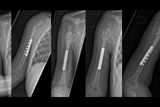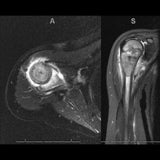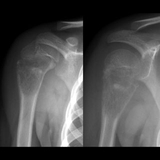

A 5-year-old boy was referred to Children’s Hospital of Philadelphia (CHOP) Orthopaedics for evaluation of a bone lesion in the right proximal humerus. According to the mother and the patient, he presented with progressive right arm pain, and difficulty in using his shoulder after a minor trauma.
Plain radiographs showed a permeative lytic lesion in the proximal aspect of the humerus, associated with new bone formation. He underwent an MRI that showed a poorly defined mass with marrow replacement, surrounding edema, and a small soft-tissue mass. After a minimally invasive, image-guided biopsy was performed by the interventional radiology team, a diagnosis of osteosarcoma was made.
Treatment planning

The patient was seen by the Oncology team and underwent staging with a PET-MRI and a chest CT, confirming the localized nature of this tumor. He was started on neoadjuvant chemotherapy, and plans for local control were initiated. Among the usual options for local control of a humerus osteosarcoma are resection followed by endoprosthetic reconstruction (a method of reconstruction in which an artificial device or prosthesis is placed inside the body) or biologic solutions utilizing bone grafting.
Since the tumor involved the proximal humerus growth plate, which is responsible for 80% of the growth of the humerus, any solution needed to take the remaining growth of the humerus into consideration, plus the expected level of activity for a 5-year-old. Endoprosthetic replacement in a young child is guaranteed to fail and would not allow a full return to activities. Bone grafting can be done from allograft (no potential for growth) or autograft. Vascularized fibular graft is often used for reconstructions following tumor resection. The preservation of the growth potential, however, requires that the epiphyseal vessels are preserved, which is a demanding and risky technique.

The Bone and Soft Tissue Tumor Program at CHOP is made up of multi-specialty surgeons capable of performing such a procedure. The patient underwent wide resection of his tumor with an adequate soft tissue margin, followed by reconstruction utilizing a vascularized fibular graft with preservation of the epiphysis and proximal fibula physis to allow growth of the humerus. All soft tissues around the shoulder, including the rotator cuff, were reconstructed to allow active motion.
Post-operative results
Postoperatively, the patient received intensive physical therapy and occupational therapy, and post-chemo he went back to being an active, now 6-year-old boy.
After a trauma, he had a fracture of the implanted fibula that healed nicely after conservative treatment, demonstrating the viability of the grafted bone. He is now one-year post-op and continues to make significant improvement of his motion and strength with no signs of local recurrence.
Surgical management of osteosarcomas in young children can be very challenging due to the potential of skeletal growth, level of activity, and expectations in this age group. With a multimodal, multidisciplinary approach, we were able to maximize local and systemic control, while providing a functional limb that should allow him to live a long and productive life.
Featured in this article
Specialties & Programs

A 5-year-old boy was referred to Children’s Hospital of Philadelphia (CHOP) Orthopaedics for evaluation of a bone lesion in the right proximal humerus. According to the mother and the patient, he presented with progressive right arm pain, and difficulty in using his shoulder after a minor trauma.
Plain radiographs showed a permeative lytic lesion in the proximal aspect of the humerus, associated with new bone formation. He underwent an MRI that showed a poorly defined mass with marrow replacement, surrounding edema, and a small soft-tissue mass. After a minimally invasive, image-guided biopsy was performed by the interventional radiology team, a diagnosis of osteosarcoma was made.
Treatment planning

The patient was seen by the Oncology team and underwent staging with a PET-MRI and a chest CT, confirming the localized nature of this tumor. He was started on neoadjuvant chemotherapy, and plans for local control were initiated. Among the usual options for local control of a humerus osteosarcoma are resection followed by endoprosthetic reconstruction (a method of reconstruction in which an artificial device or prosthesis is placed inside the body) or biologic solutions utilizing bone grafting.
Since the tumor involved the proximal humerus growth plate, which is responsible for 80% of the growth of the humerus, any solution needed to take the remaining growth of the humerus into consideration, plus the expected level of activity for a 5-year-old. Endoprosthetic replacement in a young child is guaranteed to fail and would not allow a full return to activities. Bone grafting can be done from allograft (no potential for growth) or autograft. Vascularized fibular graft is often used for reconstructions following tumor resection. The preservation of the growth potential, however, requires that the epiphyseal vessels are preserved, which is a demanding and risky technique.

The Bone and Soft Tissue Tumor Program at CHOP is made up of multi-specialty surgeons capable of performing such a procedure. The patient underwent wide resection of his tumor with an adequate soft tissue margin, followed by reconstruction utilizing a vascularized fibular graft with preservation of the epiphysis and proximal fibula physis to allow growth of the humerus. All soft tissues around the shoulder, including the rotator cuff, were reconstructed to allow active motion.
Post-operative results
Postoperatively, the patient received intensive physical therapy and occupational therapy, and post-chemo he went back to being an active, now 6-year-old boy.
After a trauma, he had a fracture of the implanted fibula that healed nicely after conservative treatment, demonstrating the viability of the grafted bone. He is now one-year post-op and continues to make significant improvement of his motion and strength with no signs of local recurrence.
Surgical management of osteosarcomas in young children can be very challenging due to the potential of skeletal growth, level of activity, and expectations in this age group. With a multimodal, multidisciplinary approach, we were able to maximize local and systemic control, while providing a functional limb that should allow him to live a long and productive life.
Contact us
Bone and Soft Tissue Tumor Program